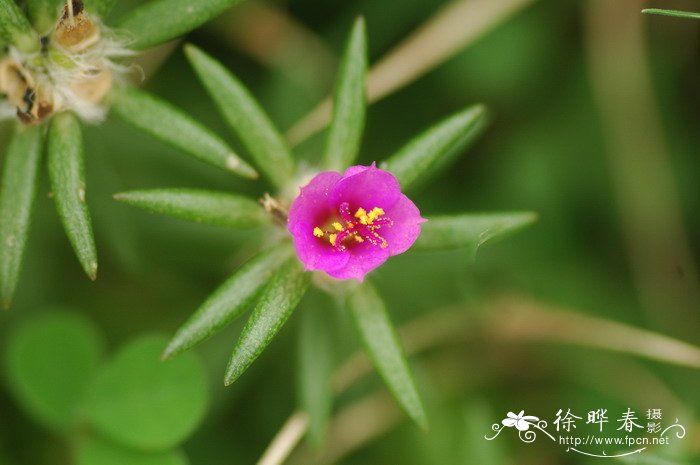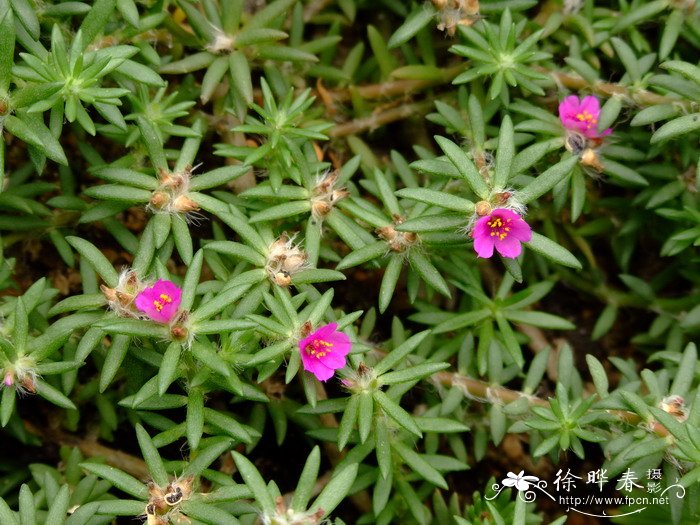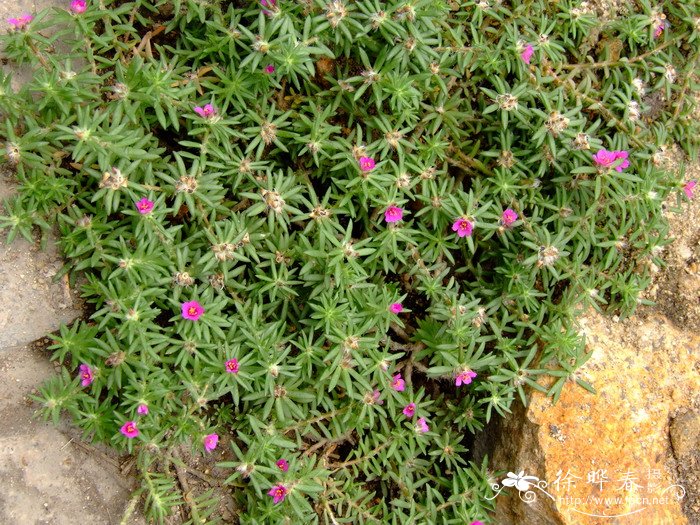毛马齿苋Portulaca pilosa
中文名(Chinese Name):毛马齿苋
学名(Scientific Name):Portulaca pilosa L.
英文名(English Common Name):kiss me quick
别名(Chinese Common Name):多毛马齿苋
异名(Synonym):Portulaca mundula I.M. Johnston Portulaca cyanosperma Engl. Portulaca ehrenbergii Poelln. Portulaca gagatosperma Millsp. Portulaca karwinskii Fisch. & E. Mey. Portulaca lanata Rich. Portulaca pilosa f. mexicana D. Legrand Portulaca poliosperma var. minor Urb.
科属(Family & Genus):马齿苋科(Portulacaceae)马齿苋属
形态特征(Description):一年生或多年生草本,高5-20厘米。茎密丛生,铺散,多分枝。叶互生,叶片近圆柱状线形或钻状狭披针形,长1-2厘米,宽1-4毫米,腋内有长疏柔毛,茎上部较密。花直径约2厘米,无梗,围以6-9片轮生叶,密生长柔毛;萼片长圆形,渐尖或急尖;花瓣5,膜质,红紫色,宽倒卵形,顶端钝或微凹,基部合生;雄蕊20-30,花丝洋红色,基部不连合;花柱短,柱头3-6裂。蒴果卵球形,蜡黄色,有光泽,盖裂;种子小,深褐黑色,有小瘤体。花、果期5-8月。
分布(Distribution):产福建、台湾、广东、海南、西沙群岛、广西、云南,多生于海边沙地及开阔地。菲律宾、马来西亚、印度尼西亚和美洲热带地区也有。
用途(Use):广东用作刀伤药,将叶捣烂贴伤处。
引自中国植物志英文版:FOC Vol. 5 Page 442
Portulaca pilosa Linnaeus, Sp. Pl. 1: 445. 1753.
毛马齿苋 mao ma chi xian| Portulacaceae | Portulaca
Herbs annual or perennial, 5-20 cm. Stems not articulated, densely caespitose, diffuse, much branched; leaf axils densely pilose. Leaves alternate; petiole absent; leaf blade terete-linear or subulate-lanceolate, 10-20 × 1-4 mm, apex acute. Flowers more than ca. 2 cm in diam., surrounded by involucre of 6-9 bracts and dense wool. Sepals oblong, apex acute or acuminate. Petals 5, red-purple, broadly obovate, connate at base, apex obtuse or slightly retuse. Stamens 20-30; filaments red, free. Style short; stigma 3-6-lobed. Capsule glossy straw colored apically, cylindric-ovoid, ca. 3 × 2.5 mm. Seeds black, with very slight purplish iridescence when mature, 0.5-0.7 mm; testa cells interlocking, domed to conic-tuberculate. Fl. and fr. May-Aug.
Dry open places near seashores. Fujian, Guangdong, Guangxi, Hainan (including Xisha Qundao), Taiwan, S Yunnan [Indonesia, Laos, Malaysia, Myanmar, Philippines, Thailand, Vietnam; Africa, America].
This name has been very widely misapplied, and much material so named belongs elsewhere. Portulaca pilosa was described from South American material but it is now a widespread weed of warm regions. Geesink (Blumea 17: 294. 1969) included virtually all species of Portulaca with linear to elliptic leaves within P. pilosa, dividing these among eight subspecies. We believe that Geesink’s treatment was too inclusive and that the complex as defined by him includes a number of distinct species in our area, such as P. insularis and P. psammotropha. The exact identity of the Chinese material needs further investigation, particularly with respect to living populations.
The plants are used for medicinal purposes.



(责任编辑:徐晔春)
学名(Scientific Name):Portulaca pilosa L.
英文名(English Common Name):kiss me quick
别名(Chinese Common Name):多毛马齿苋
异名(Synonym):Portulaca mundula I.M. Johnston Portulaca cyanosperma Engl. Portulaca ehrenbergii Poelln. Portulaca gagatosperma Millsp. Portulaca karwinskii Fisch. & E. Mey. Portulaca lanata Rich. Portulaca pilosa f. mexicana D. Legrand Portulaca poliosperma var. minor Urb.
科属(Family & Genus):马齿苋科(Portulacaceae)马齿苋属
形态特征(Description):一年生或多年生草本,高5-20厘米。茎密丛生,铺散,多分枝。叶互生,叶片近圆柱状线形或钻状狭披针形,长1-2厘米,宽1-4毫米,腋内有长疏柔毛,茎上部较密。花直径约2厘米,无梗,围以6-9片轮生叶,密生长柔毛;萼片长圆形,渐尖或急尖;花瓣5,膜质,红紫色,宽倒卵形,顶端钝或微凹,基部合生;雄蕊20-30,花丝洋红色,基部不连合;花柱短,柱头3-6裂。蒴果卵球形,蜡黄色,有光泽,盖裂;种子小,深褐黑色,有小瘤体。花、果期5-8月。
分布(Distribution):产福建、台湾、广东、海南、西沙群岛、广西、云南,多生于海边沙地及开阔地。菲律宾、马来西亚、印度尼西亚和美洲热带地区也有。
用途(Use):广东用作刀伤药,将叶捣烂贴伤处。
引自中国植物志英文版:FOC Vol. 5 Page 442
Portulaca pilosa Linnaeus, Sp. Pl. 1: 445. 1753.
毛马齿苋 mao ma chi xian| Portulacaceae | Portulaca
Herbs annual or perennial, 5-20 cm. Stems not articulated, densely caespitose, diffuse, much branched; leaf axils densely pilose. Leaves alternate; petiole absent; leaf blade terete-linear or subulate-lanceolate, 10-20 × 1-4 mm, apex acute. Flowers more than ca. 2 cm in diam., surrounded by involucre of 6-9 bracts and dense wool. Sepals oblong, apex acute or acuminate. Petals 5, red-purple, broadly obovate, connate at base, apex obtuse or slightly retuse. Stamens 20-30; filaments red, free. Style short; stigma 3-6-lobed. Capsule glossy straw colored apically, cylindric-ovoid, ca. 3 × 2.5 mm. Seeds black, with very slight purplish iridescence when mature, 0.5-0.7 mm; testa cells interlocking, domed to conic-tuberculate. Fl. and fr. May-Aug.
Dry open places near seashores. Fujian, Guangdong, Guangxi, Hainan (including Xisha Qundao), Taiwan, S Yunnan [Indonesia, Laos, Malaysia, Myanmar, Philippines, Thailand, Vietnam; Africa, America].
This name has been very widely misapplied, and much material so named belongs elsewhere. Portulaca pilosa was described from South American material but it is now a widespread weed of warm regions. Geesink (Blumea 17: 294. 1969) included virtually all species of Portulaca with linear to elliptic leaves within P. pilosa, dividing these among eight subspecies. We believe that Geesink’s treatment was too inclusive and that the complex as defined by him includes a number of distinct species in our area, such as P. insularis and P. psammotropha. The exact identity of the Chinese material needs further investigation, particularly with respect to living populations.
The plants are used for medicinal purposes.
(责任编辑:徐晔春)
踩一下[1]

顶一下[4]